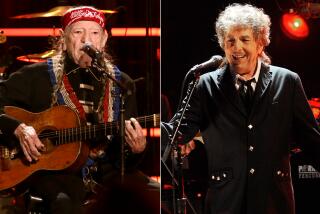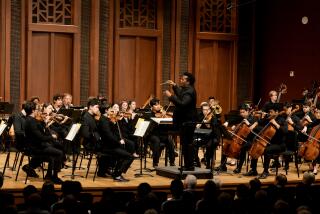JAZZ REVIEW : PETERSON, BASIE BAND: NO FUSION
- Share via
It sounded like a perfect mating for a concert: Oscar Peterson and the Count Basie Orchestra. Given Peterson’s affinity for the blues and the band’s eternal attachment to that idiom, what could be better than to bring them together?
Alas, it didn’t happen Wednesday night at the Hollywood Bowl. After the orchestra had played its set, the stage was cleared of all impedimenta except the grand piano, which was what we heard for the balance of the show.
Not that Peterson isn’t self-sufficient, as he has shown on countless occasions. However, his trio and quartet works, not to mention the occasional big-band albums, have ranked among his most felicitous accomplishments. It seemed a little like short-changing the 12,335 attendees not to team him with those 18 inspiring musicians.
Looking surprisingly heavy, but never allowing this to affect his bantamweight touch at the keyboard, Peterson opened gently with “Old Folks,” the same song to which Stacy and Jimmy Rowles had brought such lyricism last week at the Woody Herman 50th Anniversary Concert at the Bowl.
The first chorus was packed with rambling, flowery cadenzas that separated the phrases and extended the melody almost excessively; then came the swing into an easy, steady tempo, which in due course was doubled up as the intensity built.
After many years as a Peterson follower one tends to take for granted the phenomenon of his technique, even to find in it here and there more motion than emotion. Still, when the vehicle was a blues (such as one of the movements from his “Canadiana Suite”) or an occasion for some Fats Waller stride (“Honeysuckle Rose”), one’s misgivings tended to evaporate.
Peterson’s absorption in his work prevented him from sharing a surprise enjoyed only by the closer spectators: In the middle of a pensive passage, three small raccoons marched across the stage behind him and exited stage left. They never returned to take a bow.
The set ended with a long medley of songs by Billy Strayhorn (a rather too ornate “Lush Life”), Juan Tizol (a very busy “Caravan”) and Duke Ellington (a boogie beat to “C Jam Blues”). Several times his left hand went on hiatus as he used it to mop his brow. The most spectacular moments came in one of those octave-unison passages played by the two hands in parallel motion; more affecting, though, were the luminous ballads such as “Waltz for Debby” and “Round Midnight.”
The latter had already been played by the Basie band, during its generally well-rounded show, as a vehicle for the bass clarinet of John Williams. With Frank Foster as the new leader, it was clear that the orchestra will not simply rest on its laurels. Far more than his predecessor, Thad Jones, Foster featured himself as soloist (he is among the most adroit and inspired of tenor saxophonists), as composer (of the solidly swinging “Misunderstood Blues”) and arranger (of “Autumn Leaves”). He also introduced a swaggering blues penned by the drummer, Dennis Makrel. Foster is a personable conductor and amiable talker. At one point he paid a handsome tribute to Freddie Green, the guitarist, who next year will embark on his second half-century as a Basie sideman; the band then played Green’s tune “Corner Pocket.”
The solo opportunities were so well distributed that 11 men were heard from. The vocalist, Carmen Bradford, strained and faltered on “Foggy Day” but recovered nicely with two blues, “Dr. Feelgood” and “C.C. Rider.” The band wound up in a blaze of saxophonic glory as Foster, Eric Dixon and Kenny Hing traded tenor riffs on “Jumpin’ at the Woodside.” Clearly the Basie legend is in good hands.
More to Read
The biggest entertainment stories
Get our big stories about Hollywood, film, television, music, arts, culture and more right in your inbox as soon as they publish.
You may occasionally receive promotional content from the Los Angeles Times.










